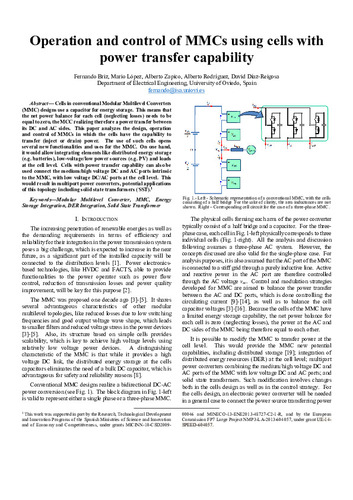Operation and control of MMCs using cells with power transfer capability
Autor(es) y otros:
Fecha de publicación:
Editorial:
IEEE
Versión del editor:
Descripción física:
Resumen:
Cells in conventional Modular Multilevel Converters (MMC) designs use a capacitor for energy storage. This means that the net power balance for each cell (neglecting losses) needs to be equal to zero, the MCC realizing therefore a power transfer between its DC and AC sides. This paper analyzes the design, operation and control of MMCs in which the cells have the capability to transfer (inject or drain) power. The use of such cells opens several new functionalities and uses for the MMC. On one hand, it would allow integrating elements like distributed energy storage (e.g. batteries), low-voltage/low power sources (e.g. PV) and loads at the cell level. Cells with power transfer capability can also be used connect the medium/high voltage DC and AC ports intrinsic to the MMC, with low voltage DC/AC ports at the cell level. This would result in multiport power converters, potential applications of this topology including solid state transformers (SST)
Cells in conventional Modular Multilevel Converters (MMC) designs use a capacitor for energy storage. This means that the net power balance for each cell (neglecting losses) needs to be equal to zero, the MCC realizing therefore a power transfer between its DC and AC sides. This paper analyzes the design, operation and control of MMCs in which the cells have the capability to transfer (inject or drain) power. The use of such cells opens several new functionalities and uses for the MMC. On one hand, it would allow integrating elements like distributed energy storage (e.g. batteries), low-voltage/low power sources (e.g. PV) and loads at the cell level. Cells with power transfer capability can also be used connect the medium/high voltage DC and AC ports intrinsic to the MMC, with low voltage DC/AC ports at the cell level. This would result in multiport power converters, potential applications of this topology including solid state transformers (SST)
ISBN:
Patrocinado por:
This work was supported in part by the Research, Technological Development and Innovation Programs of the Spanish Ministries of Science and Innovation and of Economy and Competitiveness, under grants MICINN-10-CSD2009-00046 and MINECO-13-ENE2013-48727-C2-1-R, and by the European Commission FP7 Large Project NMP3-LA-2013-604057, under grant UE-14- SPEED-604057
Colecciones
Ficheros en el ítem





